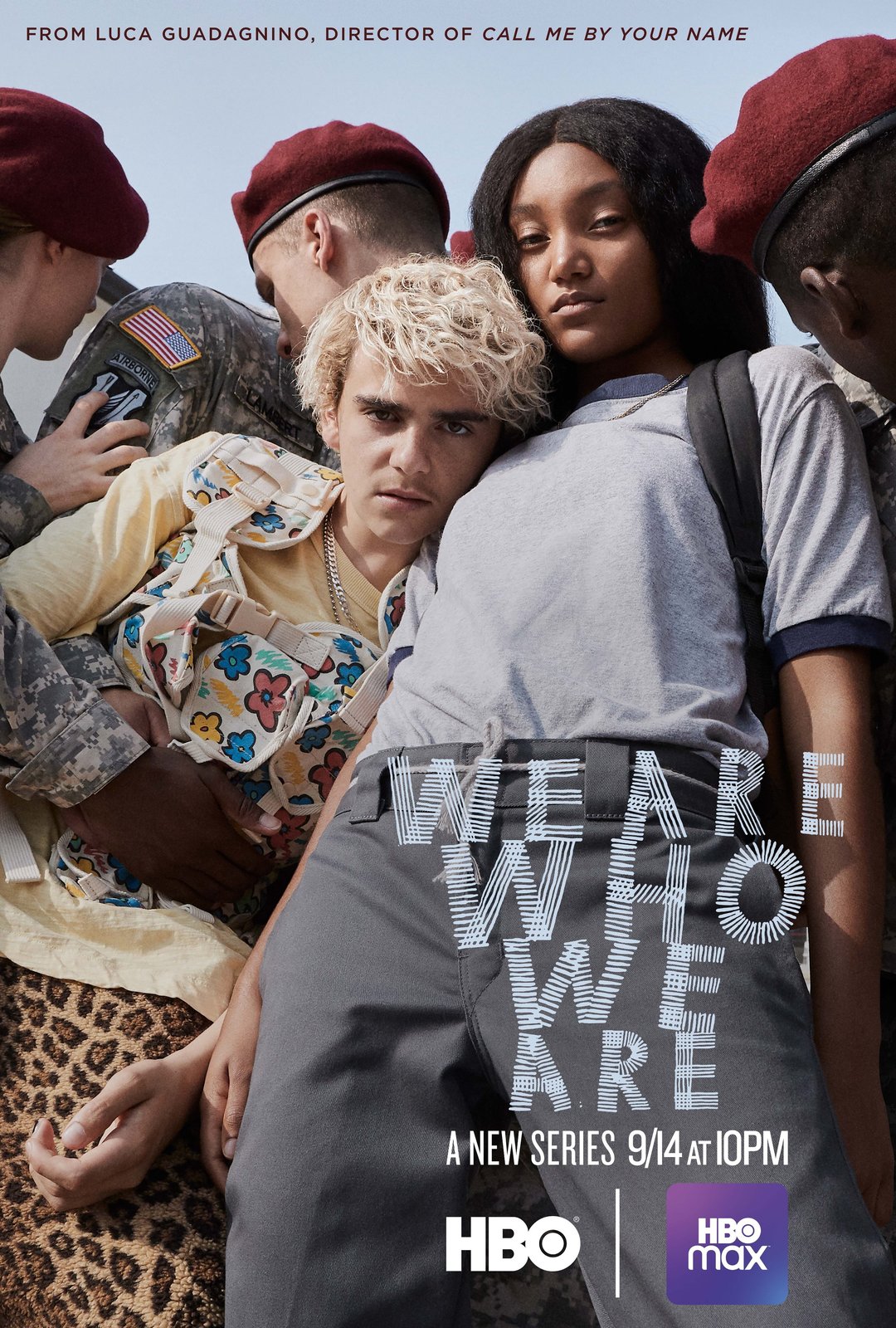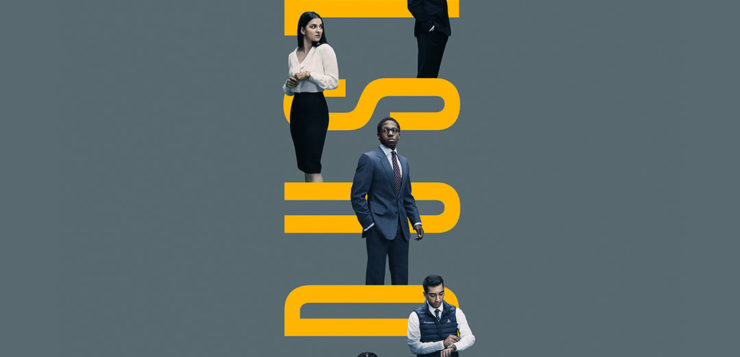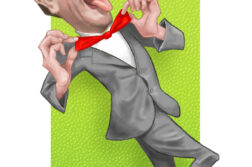 WE ARE WHO WE ARE
WE ARE WHO WE ARE
Directed by Luca Guadagnino
HBO
 INDUSTRY
INDUSTRY
Created by Mickey Down and Konrad Kay
HBO
REMEMBER THE TIME before Covid when you actually went into the office for work? Two series from HBO imagine what it would be like if the workplace were a hotbed of LGBT relationships. The first, We Are Who We Are, is set on a U.S. Army base in the coastal town of Chioggia in northern Italy, while the second, Industry, takes place in the high-stakes environment of London’s financial district. Both dramas pulse with youthful angst and gay eros.
We Are Who We Are, from director Luca Guadagnino (best known for 2017’s Call Me by Your Name), revolves around a fourteen-year-old boy named Fraser Wilson. He’s a modern-day Hamlet, half weirdo, half wallflower, and he has a mean streak. With his painted fingernails and surly attitude, his style is a mixture of Justin Bieber’s frosted highlights and Billie Eilish’s baggy clothes, and there’s the faintest mustache that suspends him between adolescence and adulthood. Setting Fraser apart further is the fact that he has two mothers. Sarah (played by Chloë Sevigny), his biological mom, is the Army base’s new commander. The series opens as she and wife Maggie (Alice Braga) arrive at the airport with an unhappy Fraser in tow. Unlike his iron-fisted mother, Fraser is lacking in self-confidence and his mom’s lesbianism only complicates the usual process of teenage self-discovery. After befriending Caitlyn, another Army brat wrestling with her own gender identity, he insists: “Just because my mom is a lesbian doesn’t mean that I’m gay,” though she is convinced otherwise. “You don’t have to not be gay either,” she replies. In the role of enfant terrible, Jack Dylan Grazer embodies Fraser with a gosling awkwardness and a vaguely villainous mustache that Caitlyn (a calm and cool Jordan Kristine Seamón) likes to mock and twirl between her fingertips. She later paints one on herself to see if she can pass in Chioggia as a Black American boy.
For Guadagnino, there’s nothing more romantic than being lost in the Italian countryside—think of Elio on his bicycle in Call Me by Your Name. In the show’s pilot, Fraser wanders the new military base before stumbling into a group shower. There he locks eyes with an Army major named Jonathan that he will later see again, rising fully naked from the sea like Botticelli’s Venus. What quickly takes shape is a tense œdipal triangle involving Fraser, Sarah, and Jonathan, who is Sarah’s assistant. Meanwhile, Fraser’s other mother, Maggie, is also straying from the marriage and pursuing a straight woman named Jenny, the wife of a Lieutenant Colonel and—wait for it—Caitlyn’s mother. If you think this sounds more like Les Liaisons Dangereuses than M*A*S*H, you’re right. Then there are Fraser’s violent outbursts, always directed at Sarah. When she doesn’t make a sandwich to his liking, he slaps her across the face before falling into her arms and begging for a baby bottle. In lieu of milk, Sarah uses red wine to calm her son’s nerves, though this soporific doesn’t always work. After being attacked a second time, Sarah fends him off before pouring herself another drink. “Why do you always want to have sex after a fight?” asks Maggie. “Why not? We’re soldiers,” says Sarah. “We’re always ready for battle.”
Everything that Guadagnino generates is highly original and visually appealing, but We Are Who We Are is often as unfocused and distractible as its adolescent subjects. A poster of Last Tango in Paris is an overt nod to his Bertoluccian influences. Even though this is his first foray into TV-storytelling, his stamp is clear. It is summer on the coast of Italy, hormones are raging, and there is no name, really, for what the characters are feeling and acting out in awkward ways. Mid-series, the entire cast (sans Sarah and Maggie) is let loose to get naked and enjoy a bacchanal inside the mansion of a Russian oligarch whose house they use for an orgiastic free-for-all. This episode, a climax of sorts, is what Guadagnino himself has called an “Eden of freedom … crazy and depraved, as daring as possible.” And while the series is indeed daring, it has difficulty getting a rhythm going. A second season seems unlikely.

By contrast, Industry has no problem with pacing, powered as it is by amphetamines, avarice, and twenty-somethings with dollar signs for eyes. By turns sexy and superficial, Industry explores youth and sex in a very different workplace environment. Or does it? An investment bank can be another kind of battlefield. In the pilot (directed by Lena Dunham), one of many young graduates competing for a limited number of positions at Pierpoint & Co. literally works himself to death after taking an overdose of uppers. The show’s heroine, Harper (Myha’la Herrold), fends off the advances of an investor named Nicole, a sugar mama played by Sarah Parish, and considers whether succumbing to Nicole’s advances will help her career.
Industry gains its luster from its glossy setting, the cacophony of the trading floor, and a character like Robert, who is deeply loyal to his gay flatmate Gus Sackey. Robert flexes fully naked in the mirror in the show’s pilot. Gus is carrying on a secret relationship with a straight guy named Theo, whom he has known since Cambridge. Robert is the protective big brother type and, looking out for Gus, tries to stop him from a midnight cab ride to Theo’s flat in Clapham. Gus ignores Robert’s advice and winds up banging drunkenly on Theo’s door; sex ensues on the sofa despite the fact that Theo’s girlfriend is asleep upstairs.
The episode, “Nutcracker,” set during the office Christmas party, brings Theo’s double life to the surface. There’s nothing like the annual office party to blur business and pleasure, often with ruinous results. With Elton John’s “Step into Christmas” blaring, the main actors slip away to bathroom stalls and vacant boardrooms where the episode’s action bursts into an inferno of drugs and sex—which is, after all, this series’ default setting. Richard lets his mates blow cocaine directly up his backside, Nicole has one too many and puts the moves on Harper, and Gus tops Theo in the bathroom before being spotted by Theo’s girlfriend. Talk about a secret Santa.
We Are Who We Are and Industry run parallel in many respects. Both cross the lines of the professional and the personal and offer further evidence of queer youth culture’s dismissal of sexual identities, as words like “gay,” “straight,” “lesbian,” “bisexual,” and “trans” go unmentioned. Aside from Fraser’s insistence that a direct line cannot be drawn between his mother’s lesbianism and his own sexuality, there’s little mention of what the kids these days dismiss as “labels.” Of course, both series are works of fiction. The question remains: is this in fact the way young people in the 21st century see themselves and their sexual identities?
Colin Carman, PhD, author of The Radical Ecology of the Shelleys, is an assistant professor of English at Colorado Mesa University.






